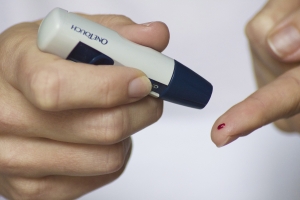Changes in mitochondria size could help manage blood sugar, study says
February 10, 2017
 Maintaining glucose, or blood sugar, levels is the key to managing type 1 and type 2 diabetes. While glucose levels vary throughout the day, a “normal range” if you have diabetes should be under 100 mg/dl for fasting blood sugar on awakening, 70–99 mg/dl for before-meal normal sugars, and less than 140 mg/dl for “postprandial” sugars taken two hours after meals, according to the American Diabetes Association (ADA). In new research published in the February 9 issue of the journal, Cell Metabolism, Yale School of Medicine researchers found that changes in the size of mitochondria in a small subset of brain cells could play a crucial role in safely maintaining blood sugar levels, a discovery that could lead to fewer complications for diabetes patients. Low blood sugar can be as dangerous as high blood sugar, experts say. The new research finds that changes in the size of mitochondria, which are responsible for energy production, in certain cells in the brain, could help maintain the blood sugar within a safe range. This new finding adds to the understanding of how the body keeps blood sugar levels within a safe range when sugar levels drop, like during fasting, or when they spike after a meal. The research team designed the study to help understand how neurons in the brain that regulate appetite affect systemic glucose levels. The team used mice for the experiment, and a specific mitochondrial protein, dynamin-related protein 1 (DRP1), was either missing or present in varying amounts in the subset of brain cells that sense circulating sugar levels. The researchers found that, depending on whether the mouse was hungry or not, mitochondria displayed dynamic changes in size and shape, driven by the DRP1 protein.When DRP1 activity in the neurons was missing, the neurons were more sensitive to changes in glucose levels What surprised the research team was that the changes in this small subset of neurons activated the counter-regulatory responses to hypoglycemia, in which the brain senses lower glucose levels and sends signals to peripheral organs such as the liver to increase glucose production. The findings suggest that alterations in this mechanism may be critical for the development of hypoglycemia-associated autonomic failure (HAAF), a complication of several diabetes treatments occurring most often in people with type 1 diabetes who must take insulin for survival. Click here to read more.
Maintaining glucose, or blood sugar, levels is the key to managing type 1 and type 2 diabetes. While glucose levels vary throughout the day, a “normal range” if you have diabetes should be under 100 mg/dl for fasting blood sugar on awakening, 70–99 mg/dl for before-meal normal sugars, and less than 140 mg/dl for “postprandial” sugars taken two hours after meals, according to the American Diabetes Association (ADA). In new research published in the February 9 issue of the journal, Cell Metabolism, Yale School of Medicine researchers found that changes in the size of mitochondria in a small subset of brain cells could play a crucial role in safely maintaining blood sugar levels, a discovery that could lead to fewer complications for diabetes patients. Low blood sugar can be as dangerous as high blood sugar, experts say. The new research finds that changes in the size of mitochondria, which are responsible for energy production, in certain cells in the brain, could help maintain the blood sugar within a safe range. This new finding adds to the understanding of how the body keeps blood sugar levels within a safe range when sugar levels drop, like during fasting, or when they spike after a meal. The research team designed the study to help understand how neurons in the brain that regulate appetite affect systemic glucose levels. The team used mice for the experiment, and a specific mitochondrial protein, dynamin-related protein 1 (DRP1), was either missing or present in varying amounts in the subset of brain cells that sense circulating sugar levels. The researchers found that, depending on whether the mouse was hungry or not, mitochondria displayed dynamic changes in size and shape, driven by the DRP1 protein.When DRP1 activity in the neurons was missing, the neurons were more sensitive to changes in glucose levels What surprised the research team was that the changes in this small subset of neurons activated the counter-regulatory responses to hypoglycemia, in which the brain senses lower glucose levels and sends signals to peripheral organs such as the liver to increase glucose production. The findings suggest that alterations in this mechanism may be critical for the development of hypoglycemia-associated autonomic failure (HAAF), a complication of several diabetes treatments occurring most often in people with type 1 diabetes who must take insulin for survival. Click here to read more.



















SHARE